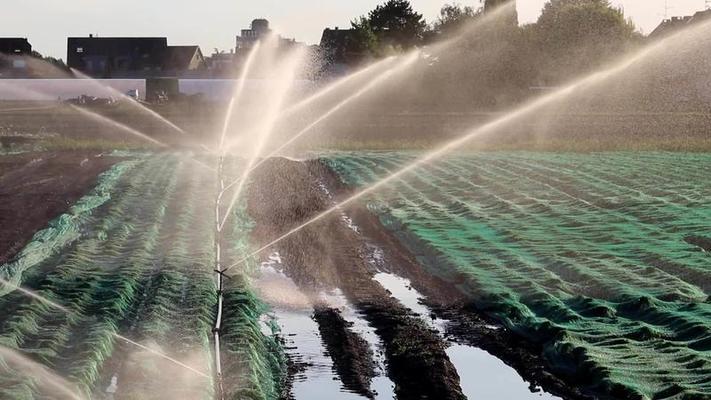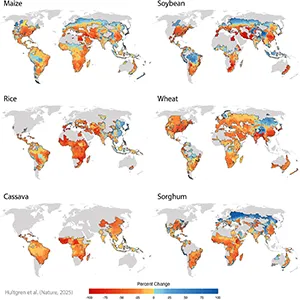Crop Water Use Trends, What it Means for Irrigation Planning – Morning Ag Clips

Report on Sustainable Water Management in Agriculture for the 2025 Growing Season
Introduction: Aligning Agricultural Practices with Sustainable Development Goals (SDGs)
An analysis of the current growing season in comparison to long-term averages provides critical insights for sustainable agricultural management. This report evaluates crop water use data to inform strategies that enhance food security and environmental stewardship, directly supporting several United Nations Sustainable Development Goals (SDGs). By optimizing water and nutrient inputs, agricultural practices can advance SDG 2 (Zero Hunger), SDG 6 (Clean Water and Sanitation), SDG 12 (Responsible Consumption and Production), and SDG 13 (Climate Action).
Analysis of Atmospheric and Crop Water Demand
Understanding the dynamics of water demand is fundamental to achieving sustainable crop production. Two key metrics, Reference Evapotranspiration (ETₒ) and Crop Evapotranspiration (ET꜀), are used to quantify these dynamics.
Reference Evapotranspiration (ETₒ)
Reference Evapotranspiration (ETₒ) measures the atmospheric demand for water from a standardized, well-watered crop surface. It integrates weather factors like temperature, solar radiation, humidity, and wind to estimate the potential water loss from the crop-soil system. High ETₒ values indicate a “thirstier” atmosphere, increasing the need for water to prevent crop stress. Monitoring ETₒ is crucial for managing water resources efficiently, a key target of SDG 6, and for adapting to the increased climate variability highlighted in SDG 13. Data from Becker, MN (2016-2024) shows a consistent seasonal peak in ETₒ during midsummer, coinciding with the most water-intensive growth stages for major crops. However, significant year-to-year variability, such as the elevated peaks in 2021 and 2022, underscores the necessity of data-driven irrigation to build resilient food systems.
Crop Evapotranspiration (ET꜀)
Crop Evapotranspiration (ET꜀) represents the actual water used by a specific crop at a given growth stage. It is calculated by adjusting ETₒ with a crop-specific coefficient (K꜀). This metric provides a precise measure of a crop’s water requirements, enabling producers to schedule irrigation in a manner that supports optimal growth while conserving water. This precision is vital for ensuring stable yields and contributing to SDG 2 (Zero Hunger).
Comparative Analysis of the 2025 Season and Implications for SDG 2
A comparative analysis of ET꜀ data reveals important trends for the 2025 growing season.
- The 2021 Season (Dry Year): ET꜀ levels surpassed the long-term average approximately 30 days after planting, indicating significant atmospheric demand and a heavy reliance on irrigation to prevent crop failure and secure food production.
- The 2025 Season (Current Year): For the first 50 days post-planting, ET꜀ has tracked closely with the long-term average. While brief spikes in demand required supplemental irrigation, timely and widespread rainfall has minimized overall irrigation needs for corn and soybean crops.
This data indicates that the 2025 season has thus far been less stressful than exceptionally dry years, supporting progress toward the stable food production targets of SDG 2. However, vigilance remains essential.
Strategic Irrigation Management: Balancing Productivity and Environmental Stewardship
While reduced irrigation is beneficial, wet conditions necessitate careful management to avoid negative environmental impacts that conflict with sustainability goals. Over-irrigation, especially when soil profiles are near capacity, poses significant risks:
- Nitrate Leaching: Excess water can wash unused nitrogen fertilizer below the root zone, contaminating groundwater. This undermines efforts to achieve SDG 6 (Clean Water and Sanitation) and protect ecosystems as per SDG 15 (Life on Land).
- Reduced Nutrient Use Efficiency: The loss of nitrogen represents a waste of resources and an economic loss for the producer, conflicting with the principles of SDG 12 (Responsible Consumption and Production).
Recommendations for Advancing Sustainable Agriculture (SDG 12 & SDG 13)
To enhance agricultural resilience and sustainability, producers are encouraged to adopt data-driven water management strategies. These tools are critical for optimizing resource use in line with SDG 12 and adapting to climate change as mandated by SDG 13.
- Integrate Soil Moisture Sensors: These devices provide real-time data on water availability in the root zone, allowing for precise irrigation that prevents both crop stress and over-watering.
- Utilize ET-Based Scheduling: Combining ET꜀ data with soil moisture readings ensures that irrigation decisions are based on actual crop needs and environmental conditions, maximizing water use efficiency.
By leveraging these technologies, the agricultural sector can fine-tune irrigation strategies, conserve water, protect water quality, and ensure resilient crop production in the face of increasing climate variability. This proactive, data-informed approach is fundamental to building a sustainable and food-secure future.
Relevant Sustainable Development Goals (SDGs)
-
SDG 2: Zero Hunger
The article’s core focus is on agricultural practices, crop health, and ensuring productivity, which are central to food security. It discusses methods to manage “crop stress risk” and achieve “resilient and sustainable crop production” for major food crops like corn and soybean.
-
SDG 6: Clean Water and Sanitation
The article extensively covers water resource management in agriculture, including “irrigation timing, water availability,” and water-use efficiency. It also directly addresses water quality by highlighting the risk of “nitrate leaching” into groundwater, which poses “environmental risks to local water quality.”
-
SDG 12: Responsible Consumption and Production
The text promotes sustainable production patterns by emphasizing the efficient use of natural resources. It advocates for data-driven approaches to “fine-tune irrigation strategies” and avoid over-irrigation, which “reduces nitrogen use efficiency,” thereby supporting the sustainable management of both water and nutrient resources.
-
SDG 13: Climate Action
The article explicitly links its subject matter to climate change, noting that “As climate variability increases, using data-driven approaches like these will remain critical to resilient and sustainable crop production.” The entire premise of comparing current conditions to long-term averages is a strategy to adapt to “shifting weather conditions” and build resilience to climate-related hazards like “hotter, drier growing seasons.”
Specific SDG Targets
-
SDG 2: Zero Hunger
- Target 2.4: By 2030, ensure sustainable food production systems and implement resilient agricultural practices that increase productivity and production… and strengthen capacity for adaptation to climate change, extreme weather, drought…
Explanation: The article directly supports this target by discussing tools and strategies for “resilient and sustainable crop production.” It emphasizes adapting to weather variability, such as “hotter, drier growing seasons,” to mitigate “crop stress risk” and ensure stable production.
- Target 2.4: By 2030, ensure sustainable food production systems and implement resilient agricultural practices that increase productivity and production… and strengthen capacity for adaptation to climate change, extreme weather, drought…
-
SDG 6: Clean Water and Sanitation
- Target 6.3: By 2030, improve water quality by reducing pollution…
Explanation: The article addresses this target by warning against the consequences of over-irrigation, which “can lead to nitrate leaching, where unused nitrogen is washed below the root zone and lost to groundwater,” directly linking agricultural practices to water pollution. - Target 6.4: By 2030, substantially increase water-use efficiency across all sectors…
Explanation: The entire article is a guide to increasing water-use efficiency in agriculture. It details how monitoring “crop evapotranspiration (ETc)” and “Reference Evapotranspiration (ETo)” allows growers to “fine-tune irrigation strategies” and avoid unnecessary water use.
- Target 6.3: By 2030, improve water quality by reducing pollution…
-
SDG 12: Responsible Consumption and Production
- Target 12.2: By 2030, achieve the sustainable management and efficient use of natural resources.
Explanation: The article promotes the efficient use of water and nutrients. It states that preventing over-irrigation “reduces nitrogen use efficiency,” and advocates for tools that “ensure that irrigation supports crop needs without contributing to nutrient losses,” which is a core principle of sustainable resource management.
- Target 12.2: By 2030, achieve the sustainable management and efficient use of natural resources.
-
SDG 13: Climate Action
- Target 13.1: Strengthen resilience and adaptive capacity to climate-related hazards and natural disasters in all countries.
Explanation: The article presents ET monitoring as a key tool for building agricultural resilience. It concludes by stating, “As climate variability increases, using data-driven approaches like these will remain critical to resilient and sustainable crop production,” directly addressing the need for adaptive capacity in the face of climate change.
- Target 13.1: Strengthen resilience and adaptive capacity to climate-related hazards and natural disasters in all countries.
Mentioned or Implied Indicators
-
SDG 2: Zero Hunger
- Indicator for Target 2.4: Level of crop water stress.
Explanation: The article implies this indicator by discussing how comparing current ET data to long-term averages provides “critical insight into… crop stress risk.” Monitoring ETc helps quantify periods of water deficit or excess, which is a measure of agricultural resilience.
- Indicator for Target 2.4: Level of crop water stress.
-
SDG 6: Clean Water and Sanitation
- Indicator for Target 6.3: Level of nitrate concentration in groundwater.
Explanation: The article explicitly mentions that “Excess water can lead to nitrate leaching… lost to groundwater,” which poses “environmental risks to local water quality.” This makes nitrate levels a direct indicator of pollution from agricultural practices. - Indicator for Target 6.4: Volume of water used per unit of crop production, measured via Crop Evapotranspiration (ETc).
Explanation: The article is centered on measuring ETc, which it defines as “the actual water use of a crop.” It provides specific values, such as ETc exceeding “0.4 inches per day,” which can be used to calculate and improve water-use efficiency.
- Indicator for Target 6.3: Level of nitrate concentration in groundwater.
-
SDG 12: Responsible Consumption and Production
- Indicator for Target 12.2: Nitrogen use efficiency.
Explanation: The article directly mentions that poor water management “reduces nitrogen use efficiency.” This implies that tracking the efficiency of nutrient use is a key metric for measuring the sustainability of production.
- Indicator for Target 12.2: Nitrogen use efficiency.
-
SDG 13: Climate Action
- Indicator for Target 13.1: Adoption of data-driven climate adaptation tools in agriculture.
Explanation: The article promotes the use of specific technologies to build resilience, stating that “Incorporating soil moisture sensors alongside ET-based scheduling can help ensure that irrigation supports crop needs.” The rate of adoption of these tools serves as an indicator of increasing adaptive capacity.
- Indicator for Target 13.1: Adoption of data-driven climate adaptation tools in agriculture.
Summary Table of SDGs, Targets, and Indicators
| SDGs | Targets | Indicators |
|---|---|---|
| SDG 2: Zero Hunger | 2.4: Ensure sustainable food production systems and implement resilient agricultural practices. | Level of crop water stress (measured by comparing actual ETc to optimal levels). |
| SDG 6: Clean Water and Sanitation | 6.3: Improve water quality by reducing pollution. | Level of nitrate concentration in groundwater. |
| 6.4: Substantially increase water-use efficiency. | Crop Evapotranspiration (ETc) as a measure of water use per crop. | |
| SDG 12: Responsible Consumption and Production | 12.2: Achieve the sustainable management and efficient use of natural resources. | Nitrogen use efficiency. |
| SDG 13: Climate Action | 13.1: Strengthen resilience and adaptive capacity to climate-related hazards. | Adoption of data-driven climate adaptation tools (e.g., ET-based scheduling, soil moisture sensors). |
Source: morningagclips.com

What is Your Reaction?
 Like
0
Like
0
 Dislike
0
Dislike
0
 Love
0
Love
0
 Funny
0
Funny
0
 Angry
0
Angry
0
 Sad
0
Sad
0
 Wow
0
Wow
0












































































